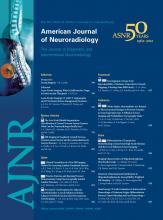Abstract
BACKGROUND AND PURPOSE: Detection of underlying tumor in patients with unknown-origin acute ICH may be difficult because acute hematoma may mask enhancement of tumor on postcontrast CT. We intended to investigate the clinical utility of DECT in differentiating tumor bleeding from pure ICH.
MATERIALS AND METHODS: Using a dual-source CT scanner, we obtained TNC single-energy and postcontrast DECT scans for 56 patients with unknown-origin spontaneous ICH. From the 2 sets of postcontrast DECT images obtained with different tube energy, EA (equivalent to conventional postcontrast CT), VNC, color-coded iodine overlay, fusion images of iodine overlay and VNC images were produced. The diagnostic performances of fusion, EA, and combined EA and TNC images for detecting underlying tumors were compared.
RESULTS: Of the 56 patients, 17 had primary or metastatic tumors (18 lesions) and 39 had nontumorous ICH. The sensitivities of fusion, EA, and combined EA and TNC images for detecting brain tumors were 94.4%, 61.1%, and 66.7%, respectively, and their specificities were 97.4%, 92.3%, and 89.7%, respectively. The areas under the ROC curves were 0.964, 0.786, and 0.842, respectively. Overall, the diagnostic performance of fusion images was significantly superior to EA (P = .006) and combined EA and TNC (P = .011) images.
CONCLUSIONS: DECT may be useful in detecting underlying tumors in patients with unknown-origin ICH.
ABBREVIATIONS:
- AUC
- area under curve
- AVM
- arteriovenous malformation
- CNR
- contrast-to-noise ratio
- DECT
- dual-energy CT
- EA
- enhanced average
- HU
- Hounsfield unit
- ICH
- intracerebral hemorrhage
- MPR
- multiplanar reformation
- ROC
- receiver operating characteristic analysis
- sd
- standard deviation
- TNC
- true noncontrast
- VNC
- virtual noncontrast
- © 2012 by American Journal of Neuroradiology












